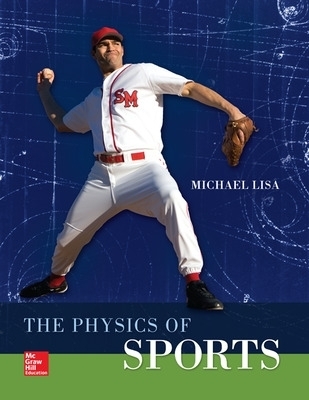
The Physics of Sports
Seiten
2015
|
UK ed.
McGraw Hill Higher Education (Verlag)
978-0-07-351397-3 (ISBN)
McGraw Hill Higher Education (Verlag)
978-0-07-351397-3 (ISBN)
Intended for a 1 semester or a 1-2 quarter undergraduate course, this book discuses physics concepts such as: force, velocity, and torque. It focuses on conveying interesting physics related facts about a particular sport, rather than developing a general appreciation and facility for scientific reasoning.
There is a large and growing number of excellent books on physics and sports. While these books are well written, educational, and often entertaining, they are simply not textbooks. Physics concepts such as: force, velocity, and torque, come into the discussion. Interesting facts are given, and occasionally a formula is applied. However, the focus is typically on conveying interesting physics related facts about a particular sport, rather than developing a general appreciation and facility for scientific reasoning. The Physics of Sports is intended as a textbook for a 1 semester or a 1-2 quarter undergraduate course, for students - not necessarily intending to major in Physical Science, Engineering, or a related field. With this course, it is hoped that a student's natural interest in athletics and the direct relevance to concrete material will bridge the gap for students, turned off by the seemingly abstract stuff covered in many undergraduate physics courses. The discussion being completely centered around real life examples, allows students to understand sports by talking about Physics.
McGraw-Hill's Connect, is also available as an optional, add on item. Connect is the only integrated learning system that empowers students by continuously adapting to deliver precisely what they need, when they need it, how they need it, so that class time is more effective. Connect allows the professor to assign homework, quizzes, and tests easily and automatically grades and records the scores of the student's work. Problems are randomized to prevent sharing of answers an may also have a "multi-step solution" which helps move the students' learning along if they experience difficulty.
There is a large and growing number of excellent books on physics and sports. While these books are well written, educational, and often entertaining, they are simply not textbooks. Physics concepts such as: force, velocity, and torque, come into the discussion. Interesting facts are given, and occasionally a formula is applied. However, the focus is typically on conveying interesting physics related facts about a particular sport, rather than developing a general appreciation and facility for scientific reasoning. The Physics of Sports is intended as a textbook for a 1 semester or a 1-2 quarter undergraduate course, for students - not necessarily intending to major in Physical Science, Engineering, or a related field. With this course, it is hoped that a student's natural interest in athletics and the direct relevance to concrete material will bridge the gap for students, turned off by the seemingly abstract stuff covered in many undergraduate physics courses. The discussion being completely centered around real life examples, allows students to understand sports by talking about Physics.
McGraw-Hill's Connect, is also available as an optional, add on item. Connect is the only integrated learning system that empowers students by continuously adapting to deliver precisely what they need, when they need it, how they need it, so that class time is more effective. Connect allows the professor to assign homework, quizzes, and tests easily and automatically grades and records the scores of the student's work. Problems are randomized to prevent sharing of answers an may also have a "multi-step solution" which helps move the students' learning along if they experience difficulty.
Primary Chapters
1) Warm-up: Basic concepts
2) Racing, Mathematically
3) Net Force: Dwight Howard illustrates
4) Punts, the Fosbury Flop, and Other Projectile Motions
5) Curveballs, Foul Shots, and Bent Kicks
6) Game Changers: Collisions in Sports
7) Energy in Sports: Bursts of Power
8) Energy and Timing in Elastic Equipment
9) The Physics of Cycling
10) Twisting Athletes in Flight
Supplementary Chapters
11) Lines of Action on the Line of Scrimmage: The Torque Wars
12) A Barry Bonds Home Run
13) The Pole Vault
14) Is It Better to Run through First Base or to Dive?
A - Unit Conversions
B - Tables of Relevant Physical Properties
Further Reading
Answers to Odd-Numbered Problems
| Erscheint lt. Verlag | 16.12.2015 |
|---|---|
| Zusatzinfo | 174 Illustrations |
| Verlagsort | London |
| Sprache | englisch |
| Maße | 216 x 274 mm |
| Gewicht | 812 g |
| Themenwelt | Sachbuch/Ratgeber ► Gesundheit / Leben / Psychologie |
| Studium ► 1. Studienabschnitt (Vorklinik) ► Physiologie | |
| ISBN-10 | 0-07-351397-0 / 0073513970 |
| ISBN-13 | 978-0-07-351397-3 / 9780073513973 |
| Zustand | Neuware |
| Haben Sie eine Frage zum Produkt? |
Mehr entdecken
aus dem Bereich
aus dem Bereich


